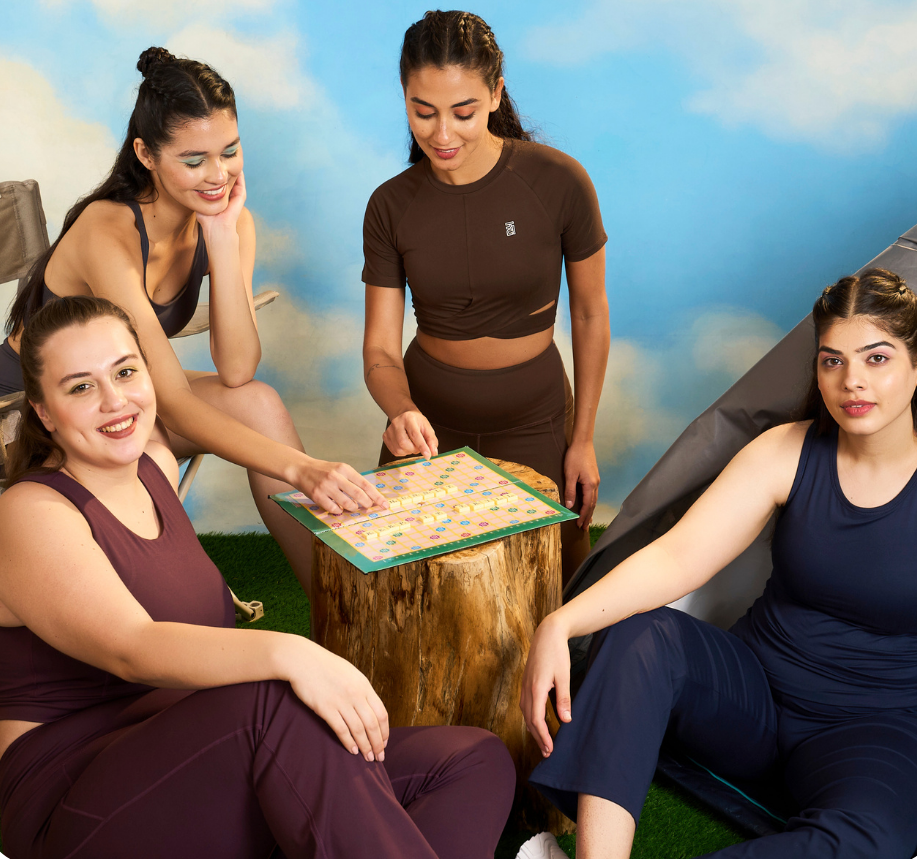Why Your Cotton Workout Shirt Is Actually Making Exercise Harder
Your favorite cotton t-shirt might be making your workouts harder than you think. That comfortable 100% cotton shirt could actually work against you during exercise. Science reveals surprising facts about cotton vs polyester shirts for workouts.
Cotton absorbs sweat rather than wicking it away from your skin. Your body cools down through sweat evaporation during exercise, but cotton soaks up moisture and fails to let it evaporate properly. This creates a big problem - wet clothing keeps sweat on your skin and prevents your body from cooling down effectively. Research shows that synthetic shirts help maintain lower body temperatures than cotton during extended workout sessions. Many serious athletes avoid cotton clothing because of these differences between cotton and synthetic materials.
We'll explore cotton's impact on your workout performance, synthetic fabric benefits, and tips to choose the right materials to improve your exercise experience.
What makes cotton a poor choice for workouts
Your favorite weekend loungewear might feel great, but workout clothing needs specific features to support your fitness routine. Cotton feels soft and comfortable at first, but it doesn't perform well during exercise.
Cotton's moisture absorption vs. moisture wicking
Let's look at the key differences between cotton vs polyester shirts in how they handle sweat. Cotton works just like a sponge—it soaks up moisture into tiny gaps called micropores that trap water inside the fabric. Moisture-wicking fabrics work differently. They pull sweat through the fabric to the outer surface where it can evaporate.
This difference matters because cotton just collects sweat and holds it against your skin. Cotton stands out as the classic example of a non-wicking fabric. It gets completely soaked with sweat and takes forever to dry. Cotton can soak up to 7% of its own weight in sweat. This creates a soggy barrier that stops proper evaporation.
Why cotton stays wet and heavy
Cotton wear gets heavier and more uncomfortable as you exercise. Research shows cotton single jersey knitted fabrics retain the most sweat. Even cotton-polyester blends come in second place for sweat retention.
You'll really notice the difference between cotton and synthetics during intense workouts. Cotton soaks up moisture instead of wicking it away. This creates what exercise physiologists call a "wet microclimate" against your skin. The fabric sticks to your body, limits your movement, and adds extra weight.
Cotton garments that resist water vapor showed higher microclimate temperature and humidity levels across most body areas. Your body's natural cooling system can't work properly with damp fabric in the way.
The impact on body temperature and comfort
Your body depends on evaporation to regulate temperature during exercise. Sweat evaporating from your skin creates a cooling effect. Wet cotton blocks this process and might raise your core temperature.
This affects you both physically and mentally. Wet cotton makes you feel hot and sticky at first. You end up feeling cold and clammy later. This isn't just about comfort—it can hurt your performance. Research shows that clothing that makes athletes feel wet and warmer reduces their maximum oxygen consumption. This means they get tired faster.
Wet cotton creates several practical problems:
-
Damp fabric rubbing against skin leads to more chafing and irritation
-
Clothes get heavier and take more energy to move in
-
Wet fabric against your skin in cool weather might cause hypothermia
Cotton vs synthetic: how fabric affects your workout
Your workout performance depends a lot on picking between synthetic and natural fibers. The technology behind fabric can impact your exercise comfort and effectiveness just like having the right shoes or equipment.
Cotton synthetic comparison: key differences
The main difference between cotton and synthetic workout wear comes from how they're built and what they can do. Cotton has cellulose with hydrogen bonding that makes it hydrophilic (water-loving), so it soaks up and holds moisture. Synthetic materials like polyester, nylon, and spandex do the opposite - they push water away instead of soaking it up.
Cotton breathes well for everyday wear, but synthetic fabrics work much better during exercise. Engineers design synthetics with moisture-wicking properties that move sweat from your body to the fabric's surface where it dries quickly. Synthetic workout clothes keep their shape after lots of stretching and washing. Cotton loses its shape as time goes by.
Why synthetic fabrics dry faster
The quick-drying magic of synthetic fabrics is simple but works great. Cotton's cellulose structure bonds with water molecules, while synthetics like polyester don't have these binding spots. This means water molecules don't stick to synthetic fabrics, letting moisture move through the material faster.
This moisture control really matters during hard workouts. Tests show synthetic shirts dry much faster than cotton during exercise because they don't soak water into their fibers. They create paths for sweat to move away from your skin, which helps your body cool down naturally through evaporation.
How synthetics support better movement and fit
Synthetic fabrics do more than handle sweat - they improve how you move and how clothes fit. Materials like spandex stretch really well, so clothes can stretch out and snap back without losing shape. You can move freely during intense workouts like HIIT, running, or yoga.
Synthetic workout clothing stays light but tough. Athletes love this for long workouts where extra weight slows them down. These fabrics also resist wrinkles and look fresh even after intense sessions. Cotton tends to look messy after just one workout.
Beyond sweat: other downsides of cotton workout gear
Cotton workout gear has several drawbacks beyond just sweat management that can affect your exercise experience.
Odor retention and bacteria buildup
Cotton and synthetic fabrics handle odor differently. Many people think cotton stays fresher because it's "natural," but research shows otherwise. The fabric soaks up sweat and creates perfect conditions for bacteria to thrive. This leads to stubborn odors that stick around even after washing. Cotton workout clothes act like sponges. They trap odors while drying and release them again once they get wet.
The bacterial communities on different fabric types tell an interesting story. Scientists compared cotton and polyester shirts after workouts and found distinct odor profiles. Cotton absorbs more moisture, which creates an ideal environment for odor-causing bacteria to multiply.
Durability issues: stretching, shrinking, fading
Sweat and friction break down cotton fibers quickly. This doesn't just make clothes look worn - it makes them less functional too. Cotton workout clothes fade over time, especially if you wash them often or expose them to sunlight.
Cotton's fiber structure causes shrinkage problems. The fibers swell up when they get wet or hot, which makes them relax from their manufactured state. Hot water in washing machines and dryer heat can make natural fibers like cotton tighten up, causing noticeable shrinking.
Why cotton wrinkles and loses shape
Cotton wear's biggest drawback is how it loses shape during exercise. The fibers lack the elasticity you find in performance fabrics. This results in sagging around areas that move a lot, like knees or waistbands.
Your cotton workout clothes stretch and bend during exercise, which makes them bag out over time. Fabric experts say cotton garments lose their shape because the fibers can't bounce back to their original form. That's why your cotton workout shirt might look messy after just one training session.
Cotton's stiffness can limit your movement, making it a poor choice for activities like yoga or aerobics.
Choosing the right fabric for your fitness goals
Your fitness activities should guide your workout apparel choices. The fabric you pick between cotton and polyester will affect how comfortable and effective your workouts are.
Is polyester good for gym workouts?
Polyester makes an excellent choice for most gym sessions. This plastic-based fabric delivers remarkable performance benefits. It's durable, breathable, light, resists wrinkles, wicks moisture, and even repels UV rays. We designed polyester for high-intensity workouts. Rather than absorbing sweat, it pulls moisture away from your skin to the fabric's surface where it evaporates quickly.
Polyester's quick-drying nature is a great way to get through daily cardio and strength training. Cotton gets bunchy and heavy once wet, but polyester helps regulate your body temperature. This lets you stay in your workout zone longer. The fabric's elasticity and durability work great for exercises needing full range of motion.
When cotton might still be okay (low-intensity days)
Cotton has its place in certain fitness scenarios, despite its drawbacks. The fabric's breathability and softness work well for low-intensity activities like yoga, stretching, or casual walks in moderate temperatures. Cotton shines on rest days or during gentle movements that don't make you sweat much.
Research shows cotton works best during slow-paced exercises where comfort matters more than performance. Note that cotton remains a good pick for outdoor activities in warm weather. Your skin breathes easily under the sun.
How to read fabric labels and choose blends
Fabric labels work like ID cards for your workout gear. The fiber percentages appear in descending order on labels. The first material listed makes up the highest percentage. Textile fibers use abbreviations: PL for Polyester, PA for Polyamide, and EA for Elastane.
Performance garments often use blends that combine different materials' benefits. To cite an instance, polyester mixed with organic cotton fights odor better while wicking moisture. Wool mixed with synthetics like spandex improves flexibility and fit.
Tips for building a better workout wardrobe
A good fitness wardrobe matches fabrics to activities. Synthetic fabrics excel in high-intensity workouts. Natural fibers suit lower-impact exercises better.
Think over these factors when picking workout clothes:
-
Activity intensity (high-intensity needs better moisture-wicking)
-
Environmental conditions (temperature, humidity, indoor vs. outdoor)
-
Proper fit (clothes should move with you, not against you)
-
Color (light-colored, lightweight moisture-wicking clothes work best in heat)
Quality matters by a lot, whatever fabric you choose. Good quality pieces with the right technical fabrics won't stretch out or look worn after a few washes.
Conclusion
Your choice of workout clothes can affect your exercise performance by a lot. Cotton feels great for everyday wear but comes with several drawbacks during exercise. The fabric soaks up moisture and creates a damp layer against your skin. This prevents your body from cooling down properly and makes you feel uncomfortable.
Synthetic fabrics are a better choice for fitness enthusiasts. These materials pull sweat away from your body and let it evaporate naturally to regulate your temperature. On top of that, they keep their shape well, fight odors better than cotton, and stretch easily with your movements.
Light activities like gentle yoga or walking work fine with cotton. Your intense workouts need specialized performance fabrics though. Take time to check those fabric labels to pick the right materials for each activity. Polyester, nylon, and spandex blends work best for tough training sessions.
The science behind your workout clothes matters more than you might think. Matching your fabric to your fitness goals will improve your exercise experience. The right gear doesn't just boost your confidence—it helps you perform better, stay comfortable, and get more from every workout session.
FAQs
Q1. Why is cotton not ideal for intense workouts?
Cotton absorbs and retains sweat, creating a wet, heavy fabric that clings to your skin. This prevents proper evaporation and cooling, making your workout feel more challenging and uncomfortable.
Q2. What are the advantages of synthetic fabrics for exercise?
Synthetic fabrics like polyester wick moisture away from your skin, dry quickly, maintain their shape, and provide better flexibility. These properties help regulate body temperature and enhance overall comfort during workouts.
Q3. Are there any situations where cotton is suitable for exercise?
Cotton can be appropriate for low-intensity activities like yoga, stretching, or casual walks in moderate temperatures. It's breathable and soft, making it comfortable for gentle movements with minimal sweating.
Q4. How do synthetic fabrics affect odor during workouts?
While synthetic fabrics are excellent for moisture management, they can retain odors more than cotton. However, allowing synthetic workout clothes to dry immediately after exercise can significantly reduce odor buildup.
Q5. What should I look for when choosing workout clothing?
Consider factors such as activity intensity, environmental conditions, proper fit, and fabric properties. Look for moisture-wicking materials for high-intensity workouts, ensure clothes don't restrict movement, and opt for lightweight, breathable fabrics in hot weather.



